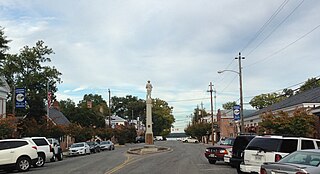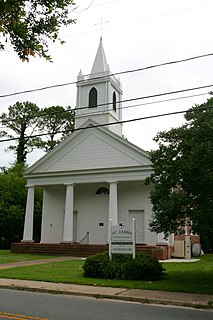
Tappahannock is the oldest town in Essex County, Virginia, United States. The population was 2,375 at the 2010 census, up from 2,068 at the 2000 census. Located on the Rappahannock River, Tappahannock is the county seat of Essex County. Its name comes from an Algonquian language word lappihanne, meaning "Town on the rise and fall of water" or "where the tide ebbs and flows." In 1608 John Smith landed in Tappahannock and fought with the local Rappahannock tribe. After defeating them, he later made peace.

A debtors' prison is a prison for people who are unable to pay debt. Through the mid-19th century, debtors' prisons were a common way to deal with unpaid debt in Western Europe. Destitute persons who were unable to pay a court-ordered judgment would be incarcerated in these prisons until they had worked off their debt via labour or secured outside funds to pay the balance. The product of their labour went towards both the costs of their incarceration and their accrued debt. Increasing access and lenience throughout the history of bankruptcy law have made prison terms for unaggravated indigence obsolete over most of the world.

Founded in 1889, the Association for the Preservation of Virginia Antiquities was the United States' first statewide historic preservation group. In 2003 the organization adopted the new name APVA Preservation Virginia to reflect a broader focus on statewide Preservation and in 2009 it shortened its name to Preservation Virginia. Preservation Virginia owns historic sites across Virginia including Historic Jamestowne, located at Jamestown, Virginia, site of the first permanent English settlement in North America, and the Cape Henry Light, one of the first public works projects of the United States of America.

Buildings, sites, districts, and objects in Virginia listed on the National Register of Historic Places:
Merchant's Hope was the name of a plantation and church established in the Virginia Colony in the 17th century. It was also the name of an English sailing ship, Merchant's Hope, which plied the Atlantic bringing emigrants to Virginia in the early 17th-century. The Merchant's Hope was owned by a man named William Barker who was a wealthy English merchant and mariner who patented land in Virginia.

The Lake County Courthouse and Sheriff's Residence, located at 601 3rd Avenue in Two Harbors, Lake County in the U.S. state of Minnesota was built in 1906. In 1888 a two-story brick sheriff's residence and jail was erected with an adjacent Queen Anne style courthouse. A 1904 fire destroyed the courthouse, but the jail and residence remained. The replacement building, designed in the Beaux Arts style by James Allen MacLeod was built of brick and limestone, featuring quoin blocks, stone window surrounds with large keystones, dentil moulding, and four large columns supporting the entry overhang. The courtroom was topped with an open semi-circular dome covered with metallic scaled shakes. In 1945, the dome was enclosed from below. Axel Edward Soderberg was commissioned to paint murals depicting "Law and Justice", commerce, mining, and logging, at a cost of $1,500 in 1905. The jail and residence building were razed in the 1990s.

The Lancaster County Jail is a historic former jail building at 208 West Gay Street. Built in 1823, it is a virtually unaltered work of the noted early American architect Robert Mills, and reflects innovative changes in jail design promoted by him. It is individually listed on the National Register of Historic Places, and was declared a National Historic Landmark in 1973.

The Debtors' Prison is a historic debtors' prison in Accomac, Virginia. Constructed in 1783 as a house for the Accomack County jailer, it is the oldest public structure in the county. It was converted to use as a debtors' prison in 1824, which purpose it served until 1849. The prison was added to the Virginia Landmarks Register and the National Register of Historic Places in 1976; along with structures in Worsham and Tappahannock, both in Virginia as well, it is one of only three debtors' prisons in the country on the National Register.

The Debtors' Prison in Tappahannock, Virginia, is a historic debtors' prison dating back to the 18th century. Constructed sometime before 1769, it is one of three such structures remaining in Virginia, along with those in Accomac and Worsham. The prison building is a contributing structure to the Tappahannock Historic District, and as such was listed on the National Register of Historic Places in 1973.

Worsham is an unincorporated community in Prince Edward County, Virginia, United States. It served as the county seat of Prince Edward County from 1754 to 1872, and as a result a number of historic public buildings may still be found there. Among these are the old debtors' prison and the old county clerk's office, both of which are listed on the National Register of Historic Places. Worsham is also the site of the old Worsham elementary school, used by the Prince Edward county school system. Near Worsham is the former Worsham High School, listed on the Register in 2010.

Grace Church is an Episcopal church in Cumberland County, Virginia. Designed by Dabney Cosby, a former assistant to Thomas Jefferson, it is the only substantial building remaining from the former community of Ca Ira. For its architectural and historical significance, Grace Church was listed on the National Register of Historic Places on October 30, 1980.

Rehoboth Church is a historic log cabin-style Methodist church in the countryside of Monroe County, West Virginia, United States, 2 miles east of the town of Union. Listed on the National Register of Historic Places since 1974, it is renowned for being the oldest existing church building in West Virginia.

The New County Jail is a structure within the Appomattox Court House National Historical Park. It was registered in the National Park Service's database of Official Structures on June 26, 1989.

St. James Church is a historic Episcopal Church on Drummondtown Road near Back Street in Accomac, Virginia, United States. Originally established as a chapel of ease for Accomack Parish in the seventeenth century, the present St. James Church was erected in 1838 as the town then known as Drummondtown grew as the county seat. In recognition of its Greek Revival design and interior trompe-l'oeil frescos, St. James Church was listed on the National Register of Historic Places in 1969. It is also a contributing building of the Accomac Historic District which was created in 1992.

Mirador is a historic home located near Greenwood, Albemarle County, Virginia. It was built in 1842 for James M. Bowen (1793–1880), and is a two-story, brick structure on a raised basement in the Federal style. It has a deck-on-hip roof capped by a Chinese Chippendale railing. The front facade features a portico with paired Tuscan order columns. The house was renovated in the 1920s by noted New York architect William Adams Delano (1874–1960), who transformed the house into a Georgian Revival mansion.

Bowman's Folly, is a historic home located near Accomac, Accomack County, Virginia. Although Captain Edmund Bowman patented the land in 1664, the current structure was built about 1815 by General John Cropper Jr., who had been born in the house in 1755. Cropper ordered it demolished and a grander building erected after construction of a hill to allow better vistas during the War of 1812. The current building has a 2 1/2-story, main block with a 1 1/2-story wing. The main block has brick ends with interior end chimneys and frame fronts on the north and south. It has a64 gable roof with dormers. The front facade features a Palladian window and pedimented entrance porch. Also on the property are a frame kitchen, now connected to the main house by a hyphen; frame dovecote, and frame privy.

Accomac Historic District is a national historic district located at Accomac, Accomack County, Virginia. The district encompasses 158 contributing buildings in the town of Accomac, mainly grouped into two periods of construction. From its founding in 1786 through the second quarter of the nineteenth century, several residential, commercial, governmental, and religious structures were built in the core of Accomac, representing both high-style and vernacular examples of late Georgian, Federal, and Greek Revival styles. Notable structures surviving from this period include the rectory of St. George's Episcopal Parish ; the Seymour House (1791-1815); Roseland (1750-1850); Seven Gables (1786-1905); Rural Hill, and the Francis Makemie Presbyterian Church (1840). The second period of construction reflected in the town dates to the last-quarter of the nineteenth century when the arrival of the New York, Philadelphia, and Norfolk Railroad spawned renewed growth and economic prosperity in Accomack County following the Civil War. These buildings also display both high-style and vernacular expressions of Victorian Era styles, including Second Empire, Italianate, Gothic Revival, and Romanesque. Notable structures from this time period include Bayly Memorial Hall, the County Clerk's Office (1887), the Accomack County Courthouse (1899), and houses found in the Lilliston Avenue extension of the town built in the 1880s-1890s. There are also contributing structures dating from the first quarter of the twentieth century, including the Drummondtown Baptist Church (1914), Drummondtown United Methodist Church (1920), and the former hotel at the town square (1925).

Tappahannock Historic District is a national historic district located at Tappahannock, Essex County, Virginia. It encompasses 14 contributing buildings dating from the 18th through late-19th centuries. They are the Customs House, Scot's Arms Tavern, Five Cents and Dollar Store, Ritchie House, Beale Memorial Baptist Church, Old Clerk's Office, Essex County Court House, Debtor's Prison, Henley House, Anderton House, Brockenbrough House, St. Margaret's Hall, Roane-Wright House, and St. John's Episcopal Church (1837-1849).

The Old Prince Edward County Clerk's Office is a historic clerk's office located at Worsham, Prince Edward County, Virginia. It was built in 1855, and is a one-story, brick building in the Roman Revival style. It features a one-story front portico with original Tuscan order columns and pilasters. It served as the clerk's office until the county seat moved to Farmville in 1872. It stands across the road from the Debtors' Prison.

Worsham High School, also known as Worsham Elementary and High School and Worsham School, is a historic high school complex located near Farmville, Prince Edward County, Virginia. It was built in 1927, and is a one- to two-story, banked brick building with a recessed, arched entrance showing influences from the Colonial Revival style. The school contains 12 classrooms on two floors arranged in a "U" around a central auditorium/classroom. Also on the property are the contributing agriculture building and cannery, both rectangular cinder block buildings built about 1927. In 1963–1964, the Worsham School was one of four County schools leased by the Prince Edward Free School system, a privately organized but federally supported organization providing free schooling for the African-American students of Prince Edward County.























